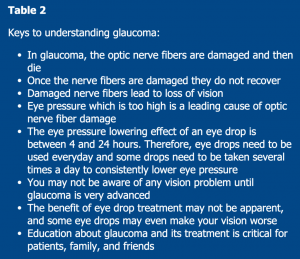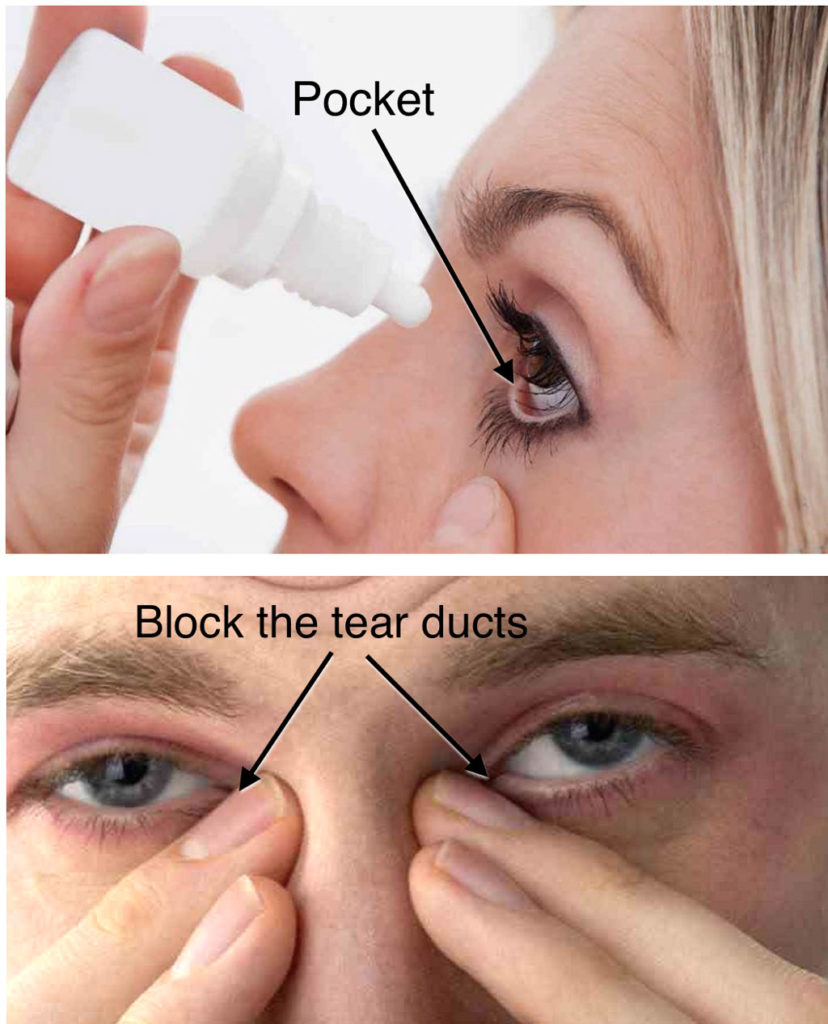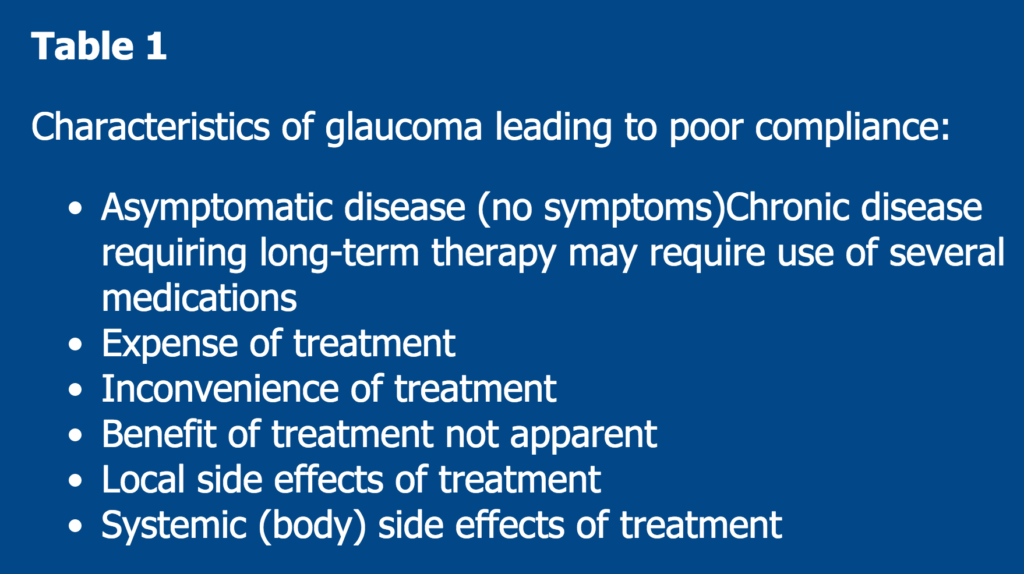Compliance with Glaucoma Treatment
Compliance with glaucoma treatment (ophthalmic eye drops) is essential to preserving your vision. Glaucoma treatment is directed at lowering eye pressure to prevent optic nerve damage and loss of vision. Initially, this is accomplished in most glaucoma patients through the use of one or more eye drops. However, it is not enough for your eye doctor simply to prescribe these drops. In partnership with your eye doctor, the best possible medications for you need to be identified. As important, you need to use the recommended eye drops!
Unless eye drops are used correctly, they will not be effective and glaucoma can worsen. Did you know that as many as one half of all glaucoma patients fail to take their eye drops correctly? For some, this means forgetting one or more doses of an eye drop. Others may remember to take them, but do so incorrectly. In this case, the eye drop may not be placed properly on the eye or may be washed out by excessive blinking or tears.
Taking an eye drop at the wrong time is also incorrect, and can lead to worsening of glaucoma. If the interval between taking the same eye drop is either too short or too long, its effectiveness will be reduced. For example, an eye drop which is taken too close to another may actually wash the first one from the outside of the eye and reduce its effectiveness. Using more than one eye drop for each eye is another way in which eye drops often are used incorrectly. Some patients are under the mistaken impression that two or more drops at a time may be more effective than one. In fact, if a single eye drop is administered correctly, then using more than one may cause a drug overdose with consequent side effects.
Compliance is the act of following the recommendations of your doctor. After all, an eye drop or any other drug will not work unless you use it correctly!
Failure to comply with your doctor’s recommendation on using eye drops is not unique to glaucoma. In fact, it is widespread and occurs throughout medicine and with virtually all diseases. In fact, it is often a reason why medical treatment of a health-related problem is not successful. For several reasons, however, the glaucoma patient is particularly likely to comply poorly with their doctor’s recommendations (Table 1).
Characteristics of glaucoma leading to poor compliance include asymptomatic disease (no symptoms)Chronic disease requiring long-term therapy may require use of several medications, expense of treatment, inconvenience of treatment, benefit of treatment not apparent, and local side effects of treatment systemic (body) side effects of treatment.
Glaucoma is Largely Asymptomatic
An individual is often unaware that they have glaucoma until late in the course of the disease. In the most common type of chronic glaucoma, it is the rule, rather than the exception, that there is no pain, redness or change in vision until the optic nerve is significantly damaged. Hence, many patients cannot be persuaded to undergo treatment, and even may deny the need for it.
Glaucoma is Chronic and Often Requires Lifelong Treatment
The most common types of glaucoma are chronic and require lifelong treatment. After being diagnosed with glaucoma, effective treatment requires the use of several medications in many instances. Use of these medications is often inconvenient and can be costly for many patients.
The Benefit of Glaucoma Treatment is Not Apparent
Treatment of many diseases is associated with measurable improvement by a patient. For example, a patient with an infection who is treated with an antibiotic often knows within hours after initial treatment that there is some improvement. In other words, it may be clear very soon that the infection is being treated successfully and that they are better. As a result, they are highly motivated to continue the treatment recommended by their doctor until it has been completed.
In contrast, an important goal of glaucoma treatment is to prevent further vision loss. Most of the time, a treated glaucoma patient cannot tell whether or not they have been treated successfully. Even if treatment is effective, their vision is most often not improved.
Treatment with any drop will only lower eye pressure temporarily. Depending on the drop, the effective duration is between four and 24 hours. However, some patients only take eye drops before seeing their eye doctor. And others are only compliant using their eye drops immediately after seeing their eye doctor. Therefore, failure to use eye drops at the recommended regular intervals throughout the entire time between appointments is an important reason why glaucoma can continue to worsen in some patients.
Glaucoma Medications Have Side Effects
Each of the medications used as an eye drop to treat glaucoma has the potential for having side effects. These side effects may be serious, or they may be barely noticeable, and limited only to a treated eye, for example, and result in decreased vision, discomfort, or redness.
Some eye drops get absorbed into the blood, and can affect heart rate, blood pressure, breathing and even mental function. Either local side effects of the eye or general ones which affect other parts of the body can cause a patient to purposefully miss one or more doses of the eye drop. They may believe that avoiding their use as prescribed by their doctor will make them feel better.
What Can be Done to Improve Compliance?

Education is perhaps the most important single means for improving compliance. A patient who is educated about the nature of glaucoma and its treatment is most likely to be a better patient, and correctly use their eye drops (Table2). You should understand that glaucoma is largely asymptomatic (has no symptoms) and that the benefits of treatment are not appreciated most of the time.
Keys to understanding glaucoma include in glaucoma, the optic nerve fibers are damaged and then die. Once the nerve fibers are damaged they do not recover and damaged nerve fibers lead to loss of vision. Eye pressure which is too high is a leading cause of optic nerve fiber damage. The eye pressure lowering effect of an eye drop is between 4 and 24 hours. Therefore, eye drops need to be used everyday and some drops need to be taken several times a day to consistently lower eye pressure. You may not be aware of any vision problem until glaucoma is very advanced. The benefit of eye drop treatment may not be apparent, and some eye drops may even make your vision worse. Education about glaucoma and its treatment is critical for patients, family, and friends
Both you and your eye doctor should enlist the support and cooperation of friends and relatives. Educating them about the effects of glaucoma and its treatment, as well as the importance of taking medications as directed, is often useful. For example, a spouse may assist you in using the eye drops so that they are properly placed and so that only one drop of a medication is given.
Reducing side effects from eye drops is important for their safe use and can improve compliance. Depending on the eye drops which are being used, this can be achieved in several different ways.
Perhaps most importantly, you should learn how to use your medications correctly. You should know how to gently close your eyelids and block your tear ducts for at least two minutes following eye drop administration. These simple maneuvers will increase the amount of drug that is absorbed into the eye and considerably reduce the amount that is absorbed undesirably into the blood.
A simple schedule for administering your eye drops also is useful. For example, many, but not all, types of beta-blocker eye drops are as effective at lowering eye pressure when given twice daily in the morning and evening. Besides being easier to remember, once daily use of a beta-blocker eye drop may cause fewer side effects than twice daily use.
A schedule of eye drop use also may be simplified by relating the time of administration to routine daily events such as awakening in the morning and going to sleep in the evening for twice daily use. For three times daily use, one may consider using the eye drop at lunchtime, as well. And for four times daily use, a simplified schedule may involve use at breakfast, lunch, dinner and bedtime.
Finally, when using more than one eye drop medication at a certain time, it is necessary to wait at least five minutes in between the use of the different drops. This allows the first eye drop to be absorbed into the eye before the second eye drop is given.
Summary
Listening to and following your eye doctor’s recommendations not only improves the likelihood of successful treatment, but allows them to determine whether the eye drops are beneficial or additional ones are needed. You should ask your eye doctor about any possible side effects from recommended treatment, and report them if they occur. Also, you should ask your eye doctor to observe your use of an eye drop so that they might determine whether it is being administered correctly. In particular, learn how to block your tear ducts after using an eye drop and remember to do this to minimize side effects throughout the body.
Don’t be afraid to discuss these issues with your eye doctor, as they are committed to provide you with the best possible chance for successful treatment of your glaucoma!
Contact us at Glaucoma Associates of Texas to find an eye doctor (ophthalmologist) specializing in medical and surgical treatment of glaucoma.

 DONATE NOW
DONATE NOW

